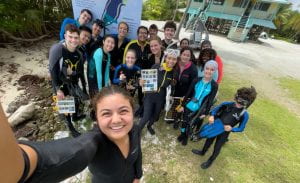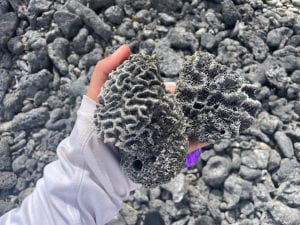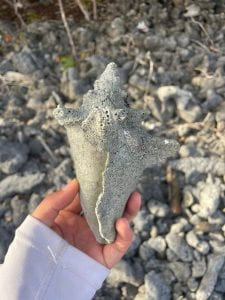Armed with dull fabric scissors, we pressed into the scaly skin of a dead lionfish until we finally cut through. Then came round two; we sliced the stomach itself until tiny fish flopped out. It was a truly gutty process: full of fish guts and requiring real human guts to stomach it.
(Lionfish Dissection – 05/29/25)
Dr. Evans and Dr. Solomon had caught wild, invasive lionfish from the surrounding reefs for both science and cuisine. First, we performed dissections to better understand their anatomy, what adaptations make them such ruthless predators, and what native fish they’ve been stealing off our reefs. My group’s lionfish had four small guppy- or wrasse-looking fish in its belly. Sam’s had a wrasse too, which he took as a personal offense since wrasses were his study taxon.
One of the main issues with lionfish that make them unstoppable invasives is that they have no natural predators in the ecosystems they enter. That, and they reproduce rapidly, laying up to 2 million eggs per year. These spiny invaders are ecosystem wreckers. So, we turned them into both a science lesson and a meal.
After we dissected and weighed the lionfish, the professors separated the edible flesh from the guts and cooked the fillets for us, served with lime, tomato, and plantain chips. Dr. Evans used the guts for another demonstration. He threw them off the dock to attract hungry fish and create a frenzy. Bonefish swarmed the remains, and even a nurse shark came by to investigate, though most of the scraps were already gone by that point.
I was feeling a bit fished out when the island staff came to the rescue. They had just gathered a wheelbarrow of…you’ll never guess…COCONUTS! My dream, my only heart’s desire. They were sharing the refreshing treat together, and I sprinted over to see if there were any extras. Luckily, there were many to spare, enough for the rest of the class. The water was so tangy and refreshing from the sun. What a lovely last-day treat and full circle from my day one of coco pleading.
(Coconuts = Happiness – 05/29/25)
Later in the day, we helped the ecosystem in a different, abiotic way. Earlier, we’d seen shorelines littered with microplastics, so we grabbed trash bags and began collecting stray plastic bottles, broken shoe soles, and even a strange little plastic lamb toy. We became frustrated when fragile plastic shards shattered in our hands but were glad to remove them from the beaches before they could break down into even tinier fragments. Even with full bags, we barely made a dent, and this is all fairly recent trash, as they do host beach cleanups.
(Trash Pick-Up – 05/29/25)
As a final goodbye to the island, we jumped off the dock for one last swim/snorkel, appreciating the refreshing and inviting crystal-clear water. I cannonballed in, followed schools of guppies and bonefish, and accidentally inhaled a little saltwater as an unexpected souvenir. I stayed near the seagrass beds, so I didn’t spot any sponges, but I took mental snapshots of every organism I could. A salty, perfect sendoff.
Peace out,
Lily H. 🙂 2025


















